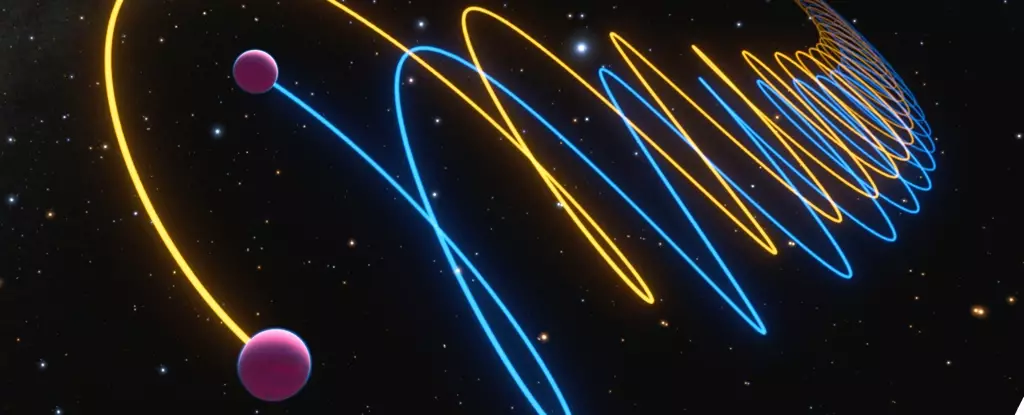The world of astrophysics is often filled with wonders and enigmas, and few discoveries capture the imagination quite like Gliese 229 B. Initially identified in 1995 by researchers at Caltech’s Palomar Observatory, this celestial object has long raised eyebrows due to its dimness relative to its considerable mass. Situated approximately 19 light-years away from Earth, Gliese 229 B was presumed to be a brown dwarf; however, recent research has revealed that this “missing link” between stars and gas giants comprises not one but two closely situated brown dwarfs. This revelation not only unravels a decades-old mystery but also opens up new avenues for exploration in the study of substellar objects.
The Caltech-led team of astronomers responsible for the discovery of Gliese 229 B initially noted its peculiar characteristics, including methane presence in its atmosphere, a feature typically associated with gas giants rather than stars. This finding was groundbreaking, as it marked the first time a brown dwarf was detected and confirmed, providing scientists with a new realm to explore in the cosmos. The brown dwarf was hailed as the “poster-child” of its kind, serving as a beacon for researchers seeking oddities in the universe.
Yet, despite the intrigue surrounding Gliese 229 B, its true nature remained elusive for nearly three decades. It’s fascinating to think that astronomers scrutinized this object for signs of brilliance characteristic of its mass, only to be left baffled by its apparent dimness. The inquiry continued amidst growing suspicion that Gliese 229 B could perhaps consist of twin objects, though the challenge lay in discerning these closely orbiting bodies, hidden from direct observation.
Cracking the Case: The Role of Advanced Observational Tools
As technology advanced, so too did our ability to peer deeper into the cosmos. The turning point came when the GRAVITY interferometer located on the European Southern Observatory’s Very Large Telescope in Chile was employed for high-resolution assessments. Through this tool, astronomers could resolve the intertwined lives of the two brown dwarfs, now confirmed as Gliese 229 Ba and Gliese 229 Bb, each with masses approximately 38 and 34 times that of Jupiter respectively.
Additionally, researchers utilized the CRyogenic high-resolution InfraRed Echelle Spectrograph (CRIRES+) to analyze distinct spectral signatures from each brown dwarf. This innovative approach allowed for measuring their Doppler shifts, further solidifying the notion that Gliese 229 B existed as a binary system rather than a solitary celestial object. The implications of this discovery were profound, aligning observed brightness levels with theoretical expectations for smaller brown dwarfs.
The confirmation of Gliese 229 B as a binary system shines a light on the intricate dynamics of substellar objects. Previously, the disparity between mass and luminosity left astronomers at odds with their theories; now, this discovery reconciles those discrepancies. According to Dimitri Mawet, a senior research scientist at NASA JPL, understanding Gliese 229 B’s true nature enhances our comprehension of brown dwarfs as a whole, which tread the fine line between star and planet classification.
Perhaps more striking is the prospect this discovery holds for future astronomical studies. As researchers investigate further, they ponder the formation mechanisms of such brown dwarf binaries. Theories suggest that these pairs could originate in the protoplanetary disks around stars, where fragmentation occurs to create two gravitationally bound entities. This notion not only holds promise for brown dwarf study but could also extend to the formation pathways of exoplanet binaries.
The quest for understanding brown dwarfs doesn’t stop here. With a strong desire among researchers to uncover more about these celestial pairs, next-generation tools like the Keck Planet Imager and Characterizer (KPIC) and the Keck Observatory’s High-resolution Infrared Spectrograph for Exoplanet Characterization (HISPEC) are set to advance observational capabilities. These instruments are under development and promise to reshape how we approach the search for brown dwarf binaries in the cosmos.
Additionally, the parallel insights gleaned from independent studies, such as those conducted by researchers at the Space Telescope Science Institute, validate the collective ambition to deepen our understanding of the universe’s complexities.
Concluding Thoughts
The uncovering of Gliese 229 B’s twin nature marks an exciting chapter in the realm of substellar astrophysics, surface a plethora of questions about the evolution and characteristics of objects that lay between the categories of stars and planets. As observations and technological advancements continue to evolve, researchers remain optimistic about the surprises awaiting discovery in the cosmos. The continued study of Gliese 229 B not only resolves past mysteries but also ignites enthusiasm for what lies beyond our galaxy’s horizon. Indeed, the universe remains a vast frontier, harboring countless enigmas yet to be unraveled.


Leave a Reply